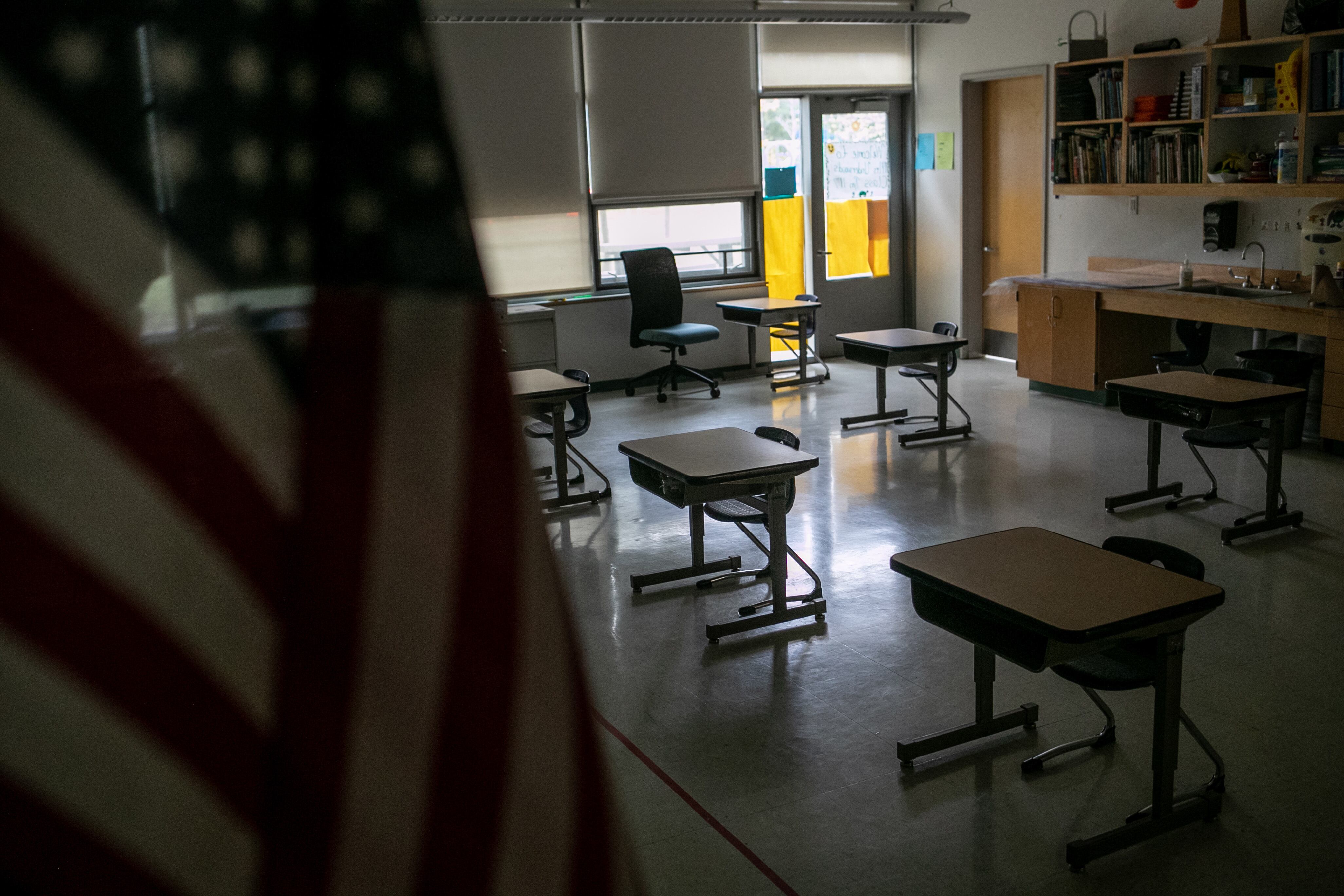Chicago Public Schools has until the start of school on Aug. 21 to train at least two employees at each of its over 600 schools in the use of student restraint and timeout or miss another deadline set by the state to comply with a 2021 state law.
If Chicago does not follow state law, the Illinois State Board of Education warned that the district could be placed under probation in a letter dated April 18. If the district does not comply, Chicago could lose state recognition meaning that it could lose state funding.
“CPS is jeopardizing the health and safety of CPS students and staff” by allowing the continued use of restraint, timeout, and seclusion by untrained staff, the state board said in the April letter to Chicago. “Students continue to experience escalating events, and staff need to be trained in the appropriate ways to de-escalate these students.”
On Monday, July 17, a spokesperson for the Illinois State Board of Education said they continue “to meet regularly with CPS to support the district’s compliance,” by the first day of classes.
Restraint, timeout, and seclusion are disciplinary tactics historically used to stop students from harming themselves or others. The state board of education defines physical restraint as when a school employee holds a student or restricts their movement, timeout is when a student is removed from a classroom for part of the school day, and seclusion is when a student is confined to a room without adult supervision. In recent years, as documented by a ProPublica and Chicago Tribune investigation, schools were found to be abusing and overusing these tactics putting children in danger and, in 2021, prompting changes to state law.
Chicago banned the use of seclusion years ago, but continues to allow restraint. Since last summer, the district has been under state watch for violating state laws governing the use of restraint and timeout in classrooms.
The letter from the state board detailed several examples in which staff who were not trained, were partially trained, or were not up-to-date with training were involved in restraint and timeout situations:
- Untrained school employees were involved in 21 incidents involving physical restraint reported between Feb. 1 and March 8. In 13 of those, at least one staff member was not properly trained and in eight incidents, none were.
- Staff at Prussing and Nixon elementary schools who were involved in incidents of restraint lasting 45 minutes did not meet training requirements.
- It is not clear if any staff members were trained in seven incidents in which students were placed in physical restraint for over 15 minutes or in timeout for over 30 minutes between Feb. 1 and March 8. The April 18 letter said the district told the state that staff were trained, but the state said they could “not corroborate those reports.”
Students with disabilities are the most likely to be restrained or put in timeout. Physical restraint can be written into a student’s Individualized Education Program under the Behavioral Intervention Plan section.
How many staff members are trained?
As of July 20, about 2,400 staff members have either completed training or were listed as “in progress,” according to a Chalkbeat analysis of a public database posted by the district. The Chalkbeat analysis found no records in the database of trained or in-training staff at 147 schools, many of which were charter schools.
In May, the district told Chalkbeat that there were 3,546 staff trained and about 422 still to be trained. Chicago Public Schools said the numbers fluctuate due to the ongoing annual training cycle, staff departures, new hires, medical leave, and other personnel reasons. The district refused to reconcile the difference between the numbers provided in May and those in the database now. A spokesperson would not say how many staff still need to be trained in order for the district to be in compliance by Aug. 21.
“Chicago Public Schools has prioritized training to ensure appropriate personnel at every school receive instruction on the use of physical restraint by the fall,” a spokesperson wrote in a statement.
A document from Chicago Public Schools obtained by Chalkbeat says that schools with up to 300 students, must have at least two staff employees trained in physical restraint and timeout. The document indicates that larger schools must have additional staff trained.
The state initially asked CPS to complete training at a subset of 77 priority schools by Feb. 17. In the April 18 letter, they requested all schools have trained staff by June 9. Spokespeople for both the district and the state confirmed the new deadline is now Aug. 21.
Trained staff are often security officers
Chalkbeat’s analysis of Chicago Public Schools’ public database shows that most staff who have been trained are school security officers. On July 20, Chalkbeat found that 1,282 security officers had completed training and 29 are “in progress,” according to the district’s data. Chicago Public Schools said security officers have been trained on restraint since before the state’s requirements were in place.
Special education teacher Katie Osgood is concerned about the number of security officers overrepresented in the database because students will have to interact with officers who might not know them or their needs like their classroom teachers.
Osgood would like schools to have trained teams — including all special education teachers and classroom assistants, school clinicians, security guards, and at least one administrator. She believes it would be better for a group of staff to perform restraint or timeout instead of one or two people.
“It needs to be a big enough team of folks so that there’s enough people in the building that can come when called to help deescalate,” Osgood said. “To make sure that other kids are kept safe, make sure adults are being kept safe, and that we’re holding ourselves accountable.”
What training looks like
Physical restraint training takes place over two days. The first day focuses on how to de-escalate a situation, or calm a student down, while the second provides hands-on training on physical restraint. School staff have to complete training annually to continue to use physical restraint.
Chicago Public Schools has contracted with QBS LLC, a crisis prevention company that trains school employees using its Safety-Care Crisis Prevention Training. The contract was approved by the school board for up to $190,050 during fiscal year 2023. Invoices obtained through an open records request and posted to MuckRock show the district has paid QBS more than $700,000 since June 2022, with nearly $500,000 being paid in March and April 2023.
The bid documents obtained by Chalkbeat indicate the company is expected to train over 2,500 school employees on how to use de-escalation techniques and physical restraint, know when restraint is needed, understand how physical restraint can affect students, and report incidents when a student is restrained.
Special Education Teacher Natasha Carlsen said she was first trained in how to use physical restraint in 2018 by QBS. At the time, she was in her eighth year of teaching students with disabilities at Camras Elementary School on the city’s Northwest Side.
Carlsen found the district’s two-day training to be useful. She said she was “incredibly impressed and felt empowered.”
Now, Carlsen is concerned that other staff members are not having the same experience. Carlsen, who also sits on a district and teachers union joint committee on special education, said she’s heard from colleagues who have yet to receive any training. Osgood also noted that most staff weren’t offered the second day of training — hands-on physical restraint training. Osgood said she has only received the first day training about de-escalation.
During the pandemic in the 2020-21 school year, Carlsen said certifications lapsed because teachers and school-based staff could not receive training in school buildings. Staff are supposed to be trained in-person annually — which the state board called “unsustainable” in its April 18 letter.
“There’s just no support, or support is out of reach, for people having significant behavioral issues with general education or special education students,” said Carlsen. “There are schools that are still using prone restraint and putting students’ lives in jeopardy of death and it is incredibly heartbreaking.”
Samantha Smylie is the state education reporter for Chalkbeat Chicago, covering school districts across the state, legislation, special education, and the state board of education. Contact Samantha at ssmylie@chalkbeat.org.








